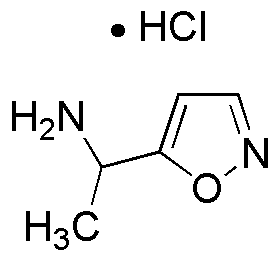1-Isoxazol-5-yl-ethylamine hydrochloride is widely utilized in research focused on:
- Pharmaceutical Development: This compound is explored for its potential in developing new medications, particularly in treating neurological disorders, due to its unique structure that may interact with specific receptors in the brain.
- Biochemical Research: It serves as a valuable tool in studying metabolic pathways and enzyme activities, helping researchers understand complex biological processes.
- Analytical Chemistry: The compound is used as a standard in various analytical methods, aiding in the quantification of similar compounds in complex mixtures.
- Material Science: Its properties are being investigated for applications in creating innovative materials, such as polymers with enhanced thermal stability and mechanical strength.
- Agrochemical Development: Researchers are exploring its potential as a building block for developing new agrochemicals that could improve crop yield and resistance to pests.
General Information
Properties
Safety and Regulations
Applications
1-Isoxazol-5-yl-ethylamine hydrochloride is widely utilized in research focused on:
- Pharmaceutical Development: This compound is explored for its potential in developing new medications, particularly in treating neurological disorders, due to its unique structure that may interact with specific receptors in the brain.
- Biochemical Research: It serves as a valuable tool in studying metabolic pathways and enzyme activities, helping researchers understand complex biological processes.
- Analytical Chemistry: The compound is used as a standard in various analytical methods, aiding in the quantification of similar compounds in complex mixtures.
- Material Science: Its properties are being investigated for applications in creating innovative materials, such as polymers with enhanced thermal stability and mechanical strength.
- Agrochemical Development: Researchers are exploring its potential as a building block for developing new agrochemicals that could improve crop yield and resistance to pests.
Documents
Safety Data Sheets (SDS)
The SDS provides comprehensive safety information on handling, storage, and disposal of the product.
Product Specification (PS)
The PS provides a comprehensive breakdown of the product’s properties, including chemical composition, physical state, purity, and storage requirements. It also details acceptable quality ranges and the product's intended applications.
Certificates of Analysis (COA)
Search for Certificates of Analysis (COA) by entering the products Lot Number. Lot and Batch Numbers can be found on a product’s label following the words ‘Lot’ or ‘Batch’.
*Catalog Number
*Lot Number
Certificates Of Origin (COO)
This COO confirms the country where the product was manufactured, and also details the materials and components used in it and whether it is derived from natural, synthetic, or other specific sources. This certificate may be required for customs, trade, and regulatory compliance.
*Catalog Number
*Lot Number
Safety Data Sheets (SDS)
The SDS provides comprehensive safety information on handling, storage, and disposal of the product.
DownloadProduct Specification (PS)
The PS provides a comprehensive breakdown of the product’s properties, including chemical composition, physical state, purity, and storage requirements. It also details acceptable quality ranges and the product's intended applications.
DownloadCertificates of Analysis (COA)
Search for Certificates of Analysis (COA) by entering the products Lot Number. Lot and Batch Numbers can be found on a product’s label following the words ‘Lot’ or ‘Batch’.
*Catalog Number
*Lot Number
Certificates Of Origin (COO)
This COO confirms the country where the product was manufactured, and also details the materials and components used in it and whether it is derived from natural, synthetic, or other specific sources. This certificate may be required for customs, trade, and regulatory compliance.


